Clovis, King of the Franks
Born: c465 r481-511
Died: 511
Father: Childeric I (436-81 r458-81)
Mother: Bassina (see DOKA)
Spouse1: Evocilde [pagan]
Spouse2: Clothilde [Christian], niece of King (Comte?) of Burgundy m493
Children:
at Clovis' death, Frankish kingdom divided among his 4 sons into Austrasia (Rheims, Metz), Neustria (Soissons), Burgundy (Paris?), Lotharia? HBHG shows Thierry son of Evochilde, all others of Clothilde
Thierry
Ingomer (died in infancy, see HoF p142)
Chlodomir, King of Orleans 511-24, k. in battle
Theodoric (Thierry) I, King of Metz (Austrasia) 511-34 (AEWH) (MBBKQ says ruled Austrasia, based at Rheims)
Childebert I, King of Paris 511-58, b. c495
Chlothar (Lothair, Clotaire) I, King of Soissons 511-58, King of all Franks 558-61, b. c497, 6 wives
? (dau) m. Ferreolus (from Springer line)
Clothilde m. Alaric, King of Visigoths (HBHG)
At right, 2 views of Clovis (from a tomb effigy?) ===>>
|
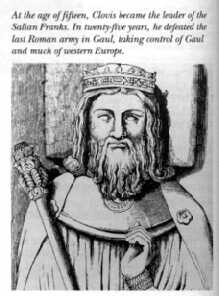
EMA p42 |
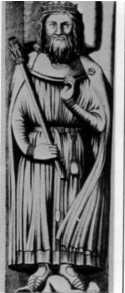
TN p? |
Clovis was the first and most powerful of the Merovingian kings, reigning 481-511. He is founder of the Frankish Noble line. He was baptized by St. Remi 24 Dec 496. He governed with a blend of Roman and Frankish traditions. In 496 he personally adopted Christianity. "He divided Gaul into about 100 counties ... such as Troyes, Flanders, Anjou, Blois, Provence, Champagne and Burgundy [many of which] still exist with the same names [today]. His most loyal generals, who became known as comtes (in English, counts) ruled the counties" (tIoC p13-4).
"The [Merovingian] dynasty's base was the triangular region connecting Reims, Tournai, and Soissons, known as the Belgica Secunda [royal residence at Paris]. From the death of the last consensus Western Roman emperor, Valentinian III, in 455, to that of the figurehead Romulus Augustulus in 476, Merovech's son Childeric effectively ruled northern Gaul. During the 260 yrs between Childeric's death in 481 and Charlemagne's birth in 742, Frankish kings shaped a new Western Empire that would be recognized internationally as Rome's successor by the turn of the 9C ... No barbarian's rule to date had been more Romanized than that of Clovis ... who chose numerous Roman advisers, lay and clerical ... he accommodated local power and authority as no RE had done ... In 507 ... Clovis fought as a client of the eastern emperor Anastasius, then at war with Italy's Ostrogoth ruler, Theodoric the Great, Clovis's bro-in-law and rival for leadership of the western barbarian kings ... [on the way home] a letter from Anastasius reached him in Tours, conferring an imperial consulate on him - an unprecedented honor for a Merovingian Frank" (AMF pp36-8).
The Oxford History of Medieval Europe (FHL, get details) states that General Aetius was the last Roman general, and after warding off Attila the Hun and many other military feats, he was murdered by Valentinian III in 454, depriving Gaul of the last effective representative of Roman military might. The following year, Valentinian III was duly murdered, presumably by soldiers loyal to Aetius. From that time, local and regional leaders began to develop, notably Childeric I in N Gaul (See image of royal stamp, p70?).
Background: Clovis, like Charlemagne later, incorporated much romanitas, preserved in the form of descendants of Roman military commanders and governors who remained in Gaul long after the fall of Rome in 476 and were respected by the Germanic and Frankish leaders. The Great Migration (East to West) began at the fall of Rome (beginning 3 centuries of Lombard v. Byzantine struggle for Italy, the former winning by 568). Another Romanizing influence was the RCC, which especially influenced Clovis and the Merovingians. Admiring the heirarchy of the RCC (which had been adopted from the Roman aristocracy), Clovis "built the first aristocratic Frankish govt, which became the dominant model for most European govts until the 20C" (13). The 5C Greek historian Procopius described the Frankish "nation in matters of trust [as] the most treacherous in the world" (14), a reputation for bravery and ruthlessness they had already gained by the time of Clovis (481 AD). After Clovis, power flowed toward local counts and bishops in the 3 succeeding kingdoms (Austrasia, Neustria, Burgundy, i.e. centralized power "was not part of Frankish culture" 15). This decentralized "system of private govt and military service that began during the time of the weak [later] Merovingian kings [was called] feudalism (from feudum, the Latin word for fief ... a piece of land granted by one noble to another) ... In 613 the Merovingian king Clothar II awarded new titles to 2 powerful and wealthy Frankish families in Austrasia for their strong military and diplomatic support. The head of one of these families, Arnulf, was named Bishop of Metz, the richest and most important city in the realm. Pepin, the head of the other loyal family, was named mayor of the palace of Austrasia" (19) ... [both are] ggggfathers of Charlemagne ... When Arnulf's son Ansegisel m. Pepin's dau Begga, these 2 roots merged to form the trunk of Charlemagne's family tree (20) ... [Austrasian] Pepin II, the gson of both Arnulf and Pepin I, helped the Merovingian king Theuderic III gain control of all 3 Frankish realms [he was clearly in charge, the king was a mere figurehead] ... [But] when Pepin II d. 16 Dec 714 ... his fragile political alliances broke apart ... The house of Pepin might have faded into history ... had it not been for his bastard son, Charles Martel ... gfather of Charlemagne, was the first in his family line to bear the name Charles ... The name Martel, which means 'the hammer' in Latin, was added by later Carolingian historians to signify [his] military and political strength ... [tho built in part by giving church lands to (often immoral) political allies, angering the RCC and damaging it spiritually, he's also famous for repulsing the Muslim Moors at Tours 732, he d. 22 Oct 741] ... Although Charles had never assumed the title of king, most Franks apparently thought of him as their king ... when Merovingian king Theuderic d737, Charles didn't bother naming a successor ... Charles divided most of his kingdom between 2 sons, Carloman, the oldest, and Pepin III, aka 'the Short,' the father of Charlemagne ... [Charles' death sparked unrest by ambitious nobles, so his sons set up the puppet king Childeric III (found him in a monastery), Carloman and Boniface focus on church purity, Pepin on politics, Pepin in Nov 751 dethrones Childeric III and becomes first Carolingian king after Carloman leaves politics for a monastery] ... This seemingly insignificant was to have great implications for the politics of Europe for several centuries [i.e. succession needn't be hereditary, more merit-based, opening path to challengers, Pope legitimized Pepin in return for securing/donating 'Papal States' in Italy, remained to 1870!] ... In addition to the conquest of [previously independent] Aquitaine, Pepin led campaigns against Arab colonies in S France and against Saxon and Frisian barbarians in N Germany. As Pepin's fame and influence spread, so did the intl recognition of the Frankish kingdom, tho still remote and barbaric v. Byzantine and Arab civilizations ... [When Pepin III d. 24 Sep 768, he] divided his kingdom between his 2 sons" ... [uneasy alliance arranged by their mother Bertrada involving m. to Desiderata in 770, created peace, but Charles felt stifled, he rebelled 771, div. Desiderata, Carloman dies suddenly 771 age 20].
See Merovingians.
Here are 2 more pics of Clovis, both taken from tIoC:
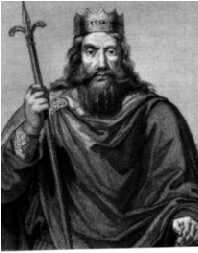
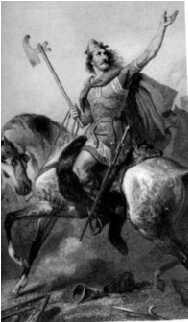
An interesting aspect of HoF is Gregory's description of numerous occasions where the trinitarian [i.e. not Arian] Christians in Gaul looked for, and received, signs from God in conducting their public affairs. This is a key aspect of medieval life and one that we've seemingly lost sight of today.
HoF: "The King of the Burgundes was called Gundioc: he was of the family of that King Athanaric who persecuted the Christians [and lived when?] ... He had 4 sons: Gundobad, Godigisel, Chilperic and Gundomar. Gundobad killed his bro Chilperic and drowned Chilperic's wife after tying a stone round her neck. He drove Chilperic's 2 daughters into exile: the elder, whose name was Chroma, became a religious [nun?], and the younger was called Clotild. Clovis often sent envoys to Burgundy and they saw the girl Clotild. They observed that she was an elegant young woman and clever for her years, and they discovered that she was of the blood royal. They reported all this to Clovis and he immediately sent more messengers to Gundobad to ask for her hand in marriage. Gundobad was afraid to refuse and he handed Clotild over to them. They took her back with them, and presented her to their King. Clovis already had a son called Theuderic by one of his mistresses, but he was delighted when he saw Clotild and made her his wife" (141). Clovis' "sister Albofled was baptized [on the same day as Clovis], but she soon after died" (144). "Another sister of Clovis, called Lanthechild, was converted at the same time" (145).
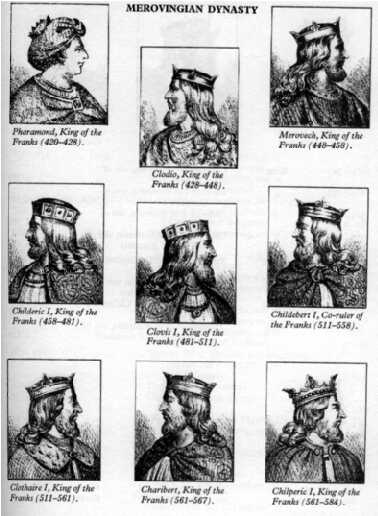
From Kings, Rulers and Statesmen, eds. L F Wise / E W Egan, Sterling (Oak Tree), 1967, 446pp, own.
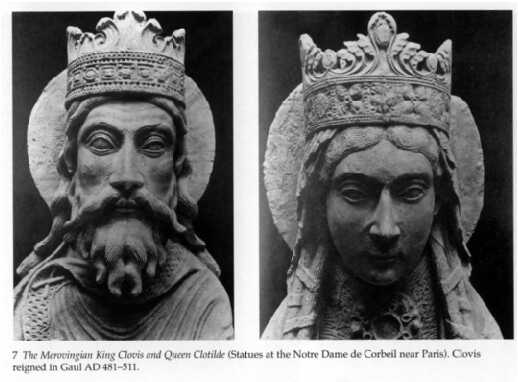
from Laurence Gardner's Bloodline of the Holy Grail (Element, 1996, p204+)
I don't accept his thesis, I just like this picture!
Sources:
- tIoC = The Importance of Charlemagne, Timothy Levi Biel, Lucent Books, 1997 (FHL).
- AMF = A Mighty Fortress: A New History of the German People, Steven Ozment, 2004, HarperCollins, Mustang
- TN = The Netherlands, author?, publisher?, year?, FHL
- EMA = The Early Middle Ages, James A Corrick, Lucent, 1995, FHL
- HoF = The History of the Franks, Gregory of Tours, 6C [Penguin 1974], own.







